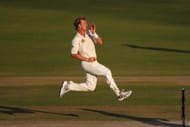“It’s very challenging”
Brett Lee never held back his inhibitions when quizzed over the occupational hazards of fast-bowling. Despite admitting the challenges of the genre, he excelled at it while wearing a constant and ever - lasting smile.
Sheer aggression embodied his style of bowling and the Aussie breathed fire at all times. With Lee lining up to bowl, it didn’t matter if you were on the placid sub-continental pitches or the lively tracks of Perth.
While constantly deploying “chin music” alongside a combination of cutters and yorkers, Lee never let a batsman at the crease relax even for a fleeting moment.
From the aggressive lot in the form of Virender Sehwag, Chris Gayle and Sachin Tendulkar to those stubborn in the mould of Rahul Dravid and Andrew Strauss - Lee accounted for batsmen of all variety while unsettling very one of them. As Akash Chopra recalled, “He made my life miserable in Sydney '04, by swinging the ball prodigiously at high speeds”.
With Akhtar, the Australian kept the fast-bowling genre alive in the 2000s. Lee recorded his fastest ball at 160.8 km/h against New Zealand in 2005.
How they compare
Lining up a Thomson against Akhtar or Lee and attempting to call out a winner would seem ludicrous as the Aussie operated in a seemingly bygone era. That said, statistics give us the leverage to compare and draw analogies. And as much as the romanticism surrounding fast-bowling begs for the comparison to be eluded, one can’t but resist the temptation.
So just how do they match up over five rounds of statistical head-to-head comparison across the tenets of speed, wickets, average, strike-rate and longevity?
Speed: If Thomson clocked 160.58 km/h in 1976, Akhtar and Lee were timed at 161.3 km/h and 160.8 km/h in 2003 and 2005 respectively. Bowling with a gargantuan run-up and powered by massive arms and shoulders, the “Rawalpindi Express” emerges the winner in this segment - albeit by a whisker.
Wickets: Lee had a stellar international career and with 310 Test wickets, leads the trio by a comfortable margin. Thomson and Akhtar trail with 200 and 178 Test wickets respectively. Lee had an even better ODI career (380 wickets) while finishing considerably ahead of Akhtar (247 wickets). Thomson, who played just 50 ODIs, finished with 55 wickets. So Lee is surely the undisputed leader of the pack as far as wickets bagged is concerned.
| Tests | Mat | Inns | Balls | Wkts | Ave | SR | Econ | 5W | 10W |
| Akhtar | 46 | 82 | 8143 | 178 | 25.69 | 45.7 | 3.37 | 12 | 2 |
| Thomson | 51 | 90 | 10535 | 200 | 28 | 52.6 | 3.18 | 8 | 0 |
| Lee | 76 | 150 | 16531 | 310 | 30.81 | 53.3 | 3.46 | 10 | 0 |
| ODIs | Mat | Inns | Balls | Wkts | Ave | Econ | SR | 5W | 10W |
| Lee | 221 | 217 | 11185 | 380 | 23.36 | 4.76 | 29.4 | 9 | 0 |
| Akhtar | 163 | 162 | 7764 | 247 | 24.97 | 4.76 | 31.4 | 4 | 0 |
| Thomson | 50 | 50 | 2696 | 55 | 35.3 | 4.32 | 49 | 0 | 0 |
Average: Despite his legendary pace, Thomson’s Test career average of 28 ranks marginally lower than that of Akhtar’s (25.69). Interestingly, Lee trails in this department (30.81). While one could argue that Lee played thirty Tests more than the Pakistani and therefore, endured a higher average, Akhtar would probably not have any of it and stake his claim for this category while throwing his weight behind his Test match economy rate (which was a shade better than that of Lee).
In the ODIs however, Lee nudges ahead of Akhtar with a superior average of 23.4. Remarkably, both the speedsters shared identical economy rates of 4.76. With Akhtar averaging better in Test cricket and Lee in ODIs, it would be fair to say that the honors are even in this segment.
Looking for fast live cricket scores? Download CricRocket and get fast score updates, top-notch commentary in-depth match stats & much more! 🚀☄️

